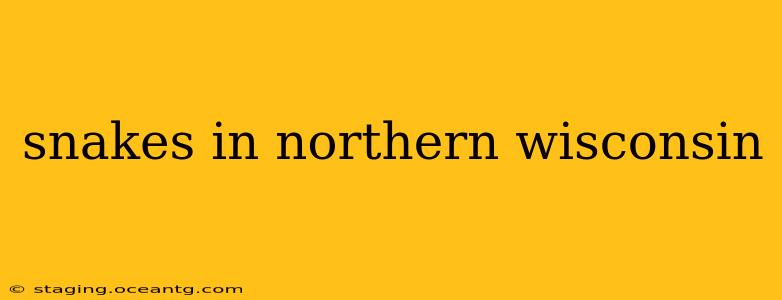Northern Wisconsin, with its diverse landscape of forests, wetlands, and lakes, provides a habitat for a variety of snake species. While some evoke fear, understanding these creatures is crucial for appreciating the ecological balance they maintain. This guide explores the snakes you might encounter in Northern Wisconsin, their characteristics, and how to coexist peacefully.
What types of snakes live in Northern Wisconsin?
Northern Wisconsin is home to a relatively small number of snake species compared to more southern regions. The most commonly encountered snakes include:
-
Garter Snakes (Thamnophis sirtalis): These are arguably the most common snakes in the region, exhibiting a variety of color patterns. They're generally non-venomous and play a crucial role in controlling rodent populations. You'll often find them near water sources.
-
Eastern Milk Snakes (Lampropeltis triangulum triangulum): These snakes are often mistaken for venomous copperheads due to their similar coloration. However, they are completely harmless and are known for their beautiful patterns. They feed primarily on rodents and other small animals.
-
Northern Water Snakes (Nerodia sipedon): These semi-aquatic snakes are often found near lakes, rivers, and marshes. They are non-venomous and have a distinctive keeled (ridged) scale pattern. They can be quite large and may appear intimidating, but they pose no threat to humans.
-
Red-bellied Snakes (Storeria occipitomaculata): These small, slender snakes are shy and secretive, often found under rocks, logs, and leaf litter. They are harmless and feed on insects and worms.
It's less common, but you might occasionally see a Smooth Greensnake (Opheodrys vernalis) in Northern Wisconsin. These are small, slender snakes that are bright green and are typically found in grassy fields and meadows.
Are there any venomous snakes in Northern Wisconsin?
While the vast majority of snakes found in Northern Wisconsin are non-venomous, the possibility of encountering a Massasauga Rattlesnake (Sistrurus catenatus) exists, although it is rare. These rattlesnakes are venomous but generally shy and avoid contact with humans. Their bite can be dangerous, so it is important to maintain a safe distance if you see one. Their range is shrinking and they are a protected species.
How can I identify a snake I find in Northern Wisconsin?
Identifying snakes can be tricky, even for experts. Avoid handling any snake you are not certain about. To help with identification, take a picture from a safe distance (using zoom if possible) and note the following:
- Size and Shape: How long is the snake? Is it slender, robust, or stocky?
- Color and Pattern: What are the primary colors? Are there bands, stripes, or spots?
- Head Shape: Is the head distinctly shaped (triangular for some venomous species) or more rounded?
- Location: Where did you see the snake? Habitat clues can be very helpful.
Use field guides, reputable online resources (such as those provided by herpetological societies), or consult with local wildlife experts for assistance.
What should I do if I encounter a snake in Northern Wisconsin?
- Maintain a safe distance: Give the snake plenty of space. Do not approach or try to handle it.
- Observe from afar: Admire its beauty and behavior without disturbing it.
- Never attempt to kill a snake: Snakes play a vital role in the ecosystem. Killing them is unnecessary and illegal in many cases.
- Educate yourself: Learn about the snakes native to your area so you can identify them and understand their behavior.
- If bitten by a snake: Seek immediate medical attention.
Are snakes dangerous in Northern Wisconsin?
Most snakes in Northern Wisconsin are harmless to humans. They are more afraid of you than you are of them and would prefer to avoid contact. The only venomous snake to be concerned about is the Massasauga Rattlesnake, which is rare and generally not aggressive.
What is the best way to prevent snake encounters in Northern Wisconsin?
- Keep your yard clean and tidy: Remove piles of wood, brush, and debris that snakes might use for shelter.
- Secure garbage cans: Keep lids tightly closed to prevent attracting rodents, which snakes prey on.
- Seal cracks and holes in your home's foundation: Prevent snakes from entering your home.
- Be cautious when hiking or spending time outdoors: Watch where you step and reach. Wear appropriate footwear.
Understanding the snakes of Northern Wisconsin fosters appreciation for these fascinating creatures and promotes safe coexistence. Remember, respect wildlife from a distance, and if unsure about a snake's identity, leave it undisturbed.
